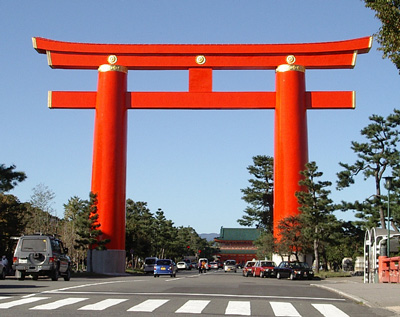| architecture |
| calligraphy |
| ceramics |
| clothing |
| comics |
| gardens |
| lacquerwork |
| literature |
| movies |
| music |
| painting |
| poetry |
| sculpture |
| tea ceremony |
| television |
| theatre |
| weaponry |
| thematic routes |
| timeline |
| the site |
context: architecture > origins > shinto
What is Shinto Architecture?

|
an 80' high torii from 1929, marking the entrance to the Heian Jingu shrine |
Essentially shinto, the ancient animistic indigenous religion of Japan, was pretty shapeless - indeed, it seems to have only been named to distinguish it from Buddhism, when that came to Japan in the 6th Century. Originally, a shinto shrine was a place of natural beauty (rocks, gnarled trees, that kind of thing) marked off with a boundary of smaller rocks or a rope. I suspect that is below the threshhold where we can talk about architecture, but I don't know what else it is - the Japanese always included the outside in their architecture, and maybe this is where that started.
From the 5th century, buildings began to be created for this purpose: the most notable shinto shrine of this kind can be seen on the next oage. There were others - Izumo is also famous - but nonetheless the practice of defining an outside space as a shrine never went away. From around the 9th Century, shinto shrines were allowed inside the precincts of Buddhist temples - shinto was interpreted as some kind of specialised local manifestation of the Buddhist spirit.
The torii (it means 'bird roost') was the standard marker of an entrance to a shinto shrine, and is one of the distinctive symbols of Japan.
